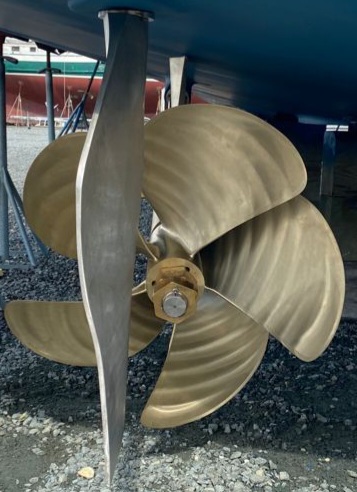When included as part of a fully optimised propulsion package, well-designed rudders can have a notable impact on maximising boat speed. They can also reduce fuel consumption, noise, vibration, and cavitation levels.
Why?
Although traditionally motor yacht rudders are straight, they operate in an area of uneven water flow directly behind the propellers. As a result, a suction pressure peak can form at or near the leading edge of the rudder. This pressure negatively impacts vessel performance and fuel consumption and is also where cavitation is more likely to occur.
Proving flow-aligned rudders improve performance
To prove the difference with flow-aligned rudders, we set up a test using a 50’ sports cruiser. During the test we compared props with standard rudders against props with flow-aligned rudders.
As you can see, swapping to flow-aligned rudders increased boat speed throughout the rev range and gave an approximate speed gain of one knot at wide-open throttle.
Predicting flow to develop flow-aligned rudders
It’s possible to accurately simulate these forces for any vessel to predict how they would impact the propulsion system’s performance. With this comprehensive understanding, we’re able to design a rudder with a unique, optimised profile – one that is perfectly aligned with the propeller flow angles along the entire span. This ‘twisted’ design reduces the suction pressure peaks, and in turn, minimises cavitation and related vibration, reduces vessel resistance and increases overall vessel performance.
7 reasons to choose flow-aligned rudders
- Optimised profile of each rudder, not an off-the-shelf approach
- Significantly improved propulsive efficiency, with no impact on vessel manoeuvrability or steering performance
- Reduced rotational losses and minimised drag provide the potential to increase top speed by up to two knots.
- Power savings provide the opportunity to reduce engine load by up to 3% at the same RPM, in turn significantly reducing fuel burn
- Lower suction pressure peaks to reduce cavitation, noise and vibration, improving both ride comfort and rudder lifespan
- Potential to downsize the steering rams to save weight and cost
- Manufactured to any classification society rules including all IACS societies
“Quick and smooth manoeuvring without any additional drag. The rudder of the future.” – Andreas Agrusta, Chief Operating Officer, NavalHEAD
For more tips on improving boat performance and reducing fuel use, please follow CJR on LinkedIn or take a look at our products and services page.
